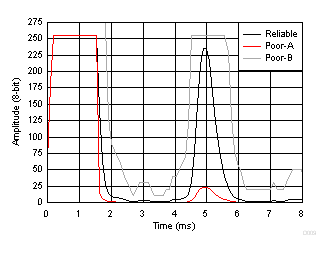SLAA732A February 2017 – April 2021 PGA460 , PGA460-Q1
5.4 Time-Varying Gain and Digital Gain
The gain features should be implemented in a manner that allows the peak echo to nearly be saturated without truncating the peak. This implementation ensures that the maximum SNR is captured in order to set the threshold timing and levels with the most amount of granularity. The gain features do not necessarily enhance the SNR but rather scale the echo data dump result to size.
The example in Figure 5-4 shows a reliable echo data dump output versus two less favorable outputs.

- RELIABLEPeak-echo amplitude nearly saturated. Properly scaled SNR of 3:1.
- POOR-AEcho amplitude too low because time-varying gain is too low and no digital gain is applied.
- POOR-BSaturated peak clamps the amplitude and effectively reduces the SNR. Also increases decay time.
The time-varying gain should increase and ramp more aggressively over time to compensate for the attenuation of sound. The digital gain multiplier is intended to help scale mid-to-long range echoes.